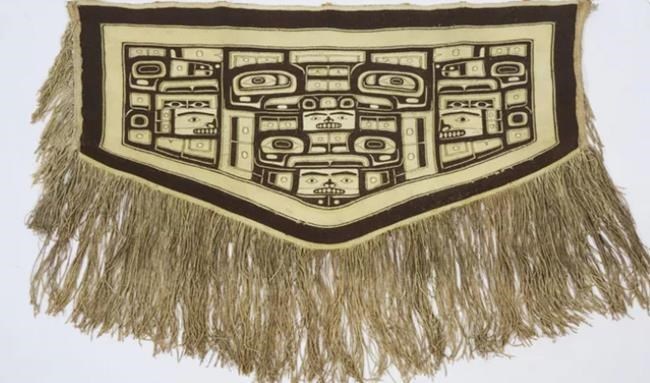ATLIN, B.C. — A man who helped return a 140-year-old Tlingit robe to the British Columbia First Nation where it was created says it's as if the regalia called out to its people and they are bringing it home.
The intricately woven Chilkat robe, made of mountain goat wool and yellow cedar bark, was purchased by the Taku River Tlingit First Nation in northwestern B.C. for almost $40,000 after it went up for sale online by a Toronto-based auction house last year.
The robe arrived in Whitehorse Wednesday and will travel 175 kilometres south to the First Nation's traditional territory in Atlin, B.C., where it's expected to go on display and may be used in future ceremonies.
While the community celebrates the return of a piece of its heritage, the First Nation said Indigenous people should not be forced to buy back regalia that was stolen from them.
It's calling on the federal government to take action to prevent similar situations in the future.
Tlingit elder and master carver Wayne Carlick said his heart "probably exploded" when the robe's close connection to his community was confirmed after he saw it online.
As an artist and residential school survivor, Carlick said looking at the robe and understanding the history it represents makes him emotional.
“I think about when I got home from residential school, I didn't see any art, I didn't see any language, I didn't see any dancing or singing. People were suffering and really hurting and there was no art,” he said in an interview from the airport in Vancouver.
“It took a long time before I started seeing First Nation’s art, West Coast First Nation’s art, and so it took a long time to get to this point.”
Carlick said getting the robe back is a chance for the younger generation to see art in a way he couldn’t at their age, and to learn about the nation's history and resilience.
It was late last year when a friend of Carlick’s first spotted the robe up for auction and sent him the online link.
Carlick said he’s seen many similar items but this was the first one he’s come across with wolves, an animal common in Taku River Tlingit culture.
The pair started doing research, calling museums around North America, before coming to the realization the robe was from a well-known Taku River Tlingit family.
Carlick's friend, an Atlin local named Peter Wright, agreed to step in and bid for the robe, with the understanding that the First Nation would pay him back.
The Taku River Tlingit said in a statement in December that the piece was originally expected to sell for an estimated $15,000 to $20,000 but came in at a staggering $38,000.
It's unclear how the item came to be part of a private collection in Ontario.
The First Nation's spokesperson said in a statement Wednesday that they are overjoyed that a piece of their heritage is being returned.
“This long-awaited homecoming fills our hearts with happiness and strengthens our spiritual connection to our ancestors. However, we must acknowledge that repairing our First Nation relationships with the federal government is equally crucial,” the statement said.
“It is unacceptable that any First Nation should have to purchase their stolen property back, and we urge the government to take responsibility for this issue. In accordance with (The United Nations Declaration on the Rights of Indigenous Peoples), the government must prioritize truth and reconciliation efforts, including addressing these types of injustices.”
The First Nation has said there are currently hundreds of pieces of Tlingit art in distant museums and private art collections, meaning community members rarely have opportunities to see them.
Ben Louter, a heritage archeologist with the Taku River Tlingit, said a special display case for the robe is being built by experts in New York and it will be installed at the First Nation government's office in Atlin.
The glass protects the delicate fibres from UV rays and the case is humidity controlled.
An official repatriation ceremony is scheduled for July as part of a three-day event involving all Canadian Inland Tlingit communities.
This report by The Canadian Press was first published June 7, 2023
Ashley Joannou, The Canadian Press




